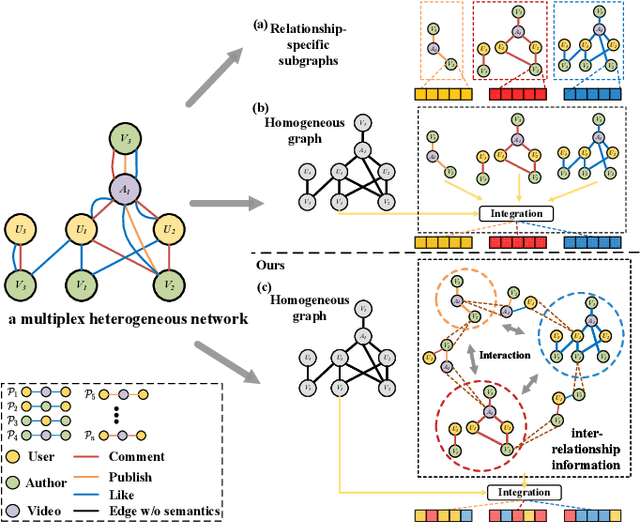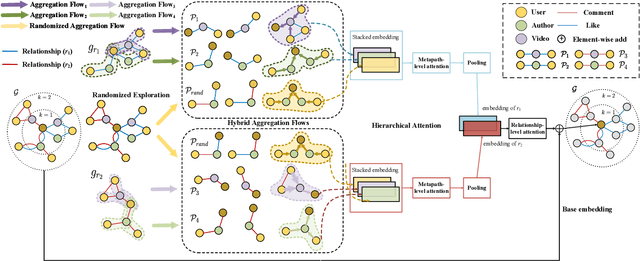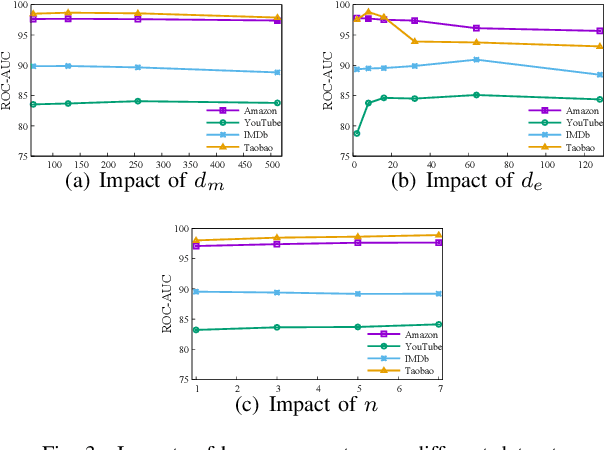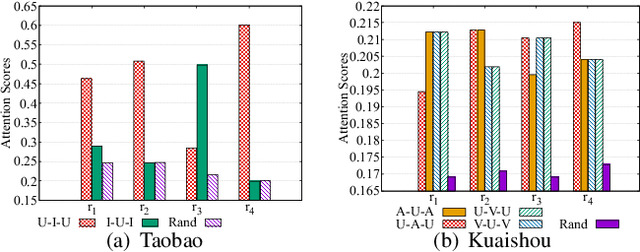Changping Wang
HybridGNN: Learning Hybrid Representation in Multiplex Heterogeneous Networks
Aug 03, 2022



Abstract:Recently, graph neural networks have shown the superiority of modeling the complex topological structures in heterogeneous network-based recommender systems. Due to the diverse interactions among nodes and abundant semantics emerging from diverse types of nodes and edges, there is a bursting research interest in learning expressive node representations in multiplex heterogeneous networks. One of the most important tasks in recommender systems is to predict the potential connection between two nodes under a specific edge type (i.e., relationship). Although existing studies utilize explicit metapaths to aggregate neighbors, practically they only consider intra-relationship metapaths and thus fail to leverage the potential uplift by inter-relationship information. Moreover, it is not always straightforward to exploit inter-relationship metapaths comprehensively under diverse relationships, especially with the increasing number of node and edge types. In addition, contributions of different relationships between two nodes are difficult to measure. To address the challenges, we propose HybridGNN, an end-to-end GNN model with hybrid aggregation flows and hierarchical attentions to fully utilize the heterogeneity in the multiplex scenarios. Specifically, HybridGNN applies a randomized inter-relationship exploration module to exploit the multiplexity property among different relationships. Then, our model leverages hybrid aggregation flows under intra-relationship metapaths and randomized exploration to learn the rich semantics. To explore the importance of different aggregation flow and take advantage of the multiplexity property, we bring forward a novel hierarchical attention module which leverages both metapath-level attention and relationship-level attention. Extensive experimental results suggest that HybridGNN achieves the best performance compared to several state-of-the-art baselines.
Concept-Aware Denoising Graph Neural Network for Micro-Video Recommendation
Sep 28, 2021



Abstract:Recently, micro-video sharing platforms such as Kuaishou and Tiktok have become a major source of information for people's lives. Thanks to the large traffic volume, short video lifespan and streaming fashion of these services, it has become more and more pressing to improve the existing recommender systems to accommodate these challenges in a cost-effective way. In this paper, we propose a novel concept-aware denoising graph neural network (named CONDE) for micro-video recommendation. CONDE consists of a three-phase graph convolution process to derive user and micro-video representations: warm-up propagation, graph denoising and preference refinement. A heterogeneous tripartite graph is constructed by connecting user nodes with video nodes, and video nodes with associated concept nodes, extracted from captions and comments of the videos. To address the noisy information in the graph, we introduce a user-oriented graph denoising phase to extract a subgraph which can better reflect the user's preference. Despite the main focus of micro-video recommendation in this paper, we also show that our method can be generalized to other types of tasks. Therefore, we also conduct empirical studies on a well-known public E-commerce dataset. The experimental results suggest that the proposed CONDE achieves significantly better recommendation performance than the existing state-of-the-art solutions.
Expanding Semantic Knowledge for Zero-shot Graph Embedding
Mar 23, 2021


Abstract:Zero-shot graph embedding is a major challenge for supervised graph learning. Although a recent method RECT has shown promising performance, its working mechanisms are not clear and still needs lots of training data. In this paper, we give deep insights into RECT, and address its fundamental limits. We show that its core part is a GNN prototypical model in which a class prototype is described by its mean feature vector. As such, RECT maps nodes from the raw-input feature space into an intermediate-level semantic space that connects the raw-input features to both seen and unseen classes. This mechanism makes RECT work well on both seen and unseen classes, which however also reduces the discrimination. To realize its full potentials, we propose two label expansion strategies. Specifically, besides expanding the labeled node set of seen classes, we can also expand that of unseen classes. Experiments on real-world datasets validate the superiority of our methods.
 Add to Chrome
Add to Chrome Add to Firefox
Add to Firefox Add to Edge
Add to Edge